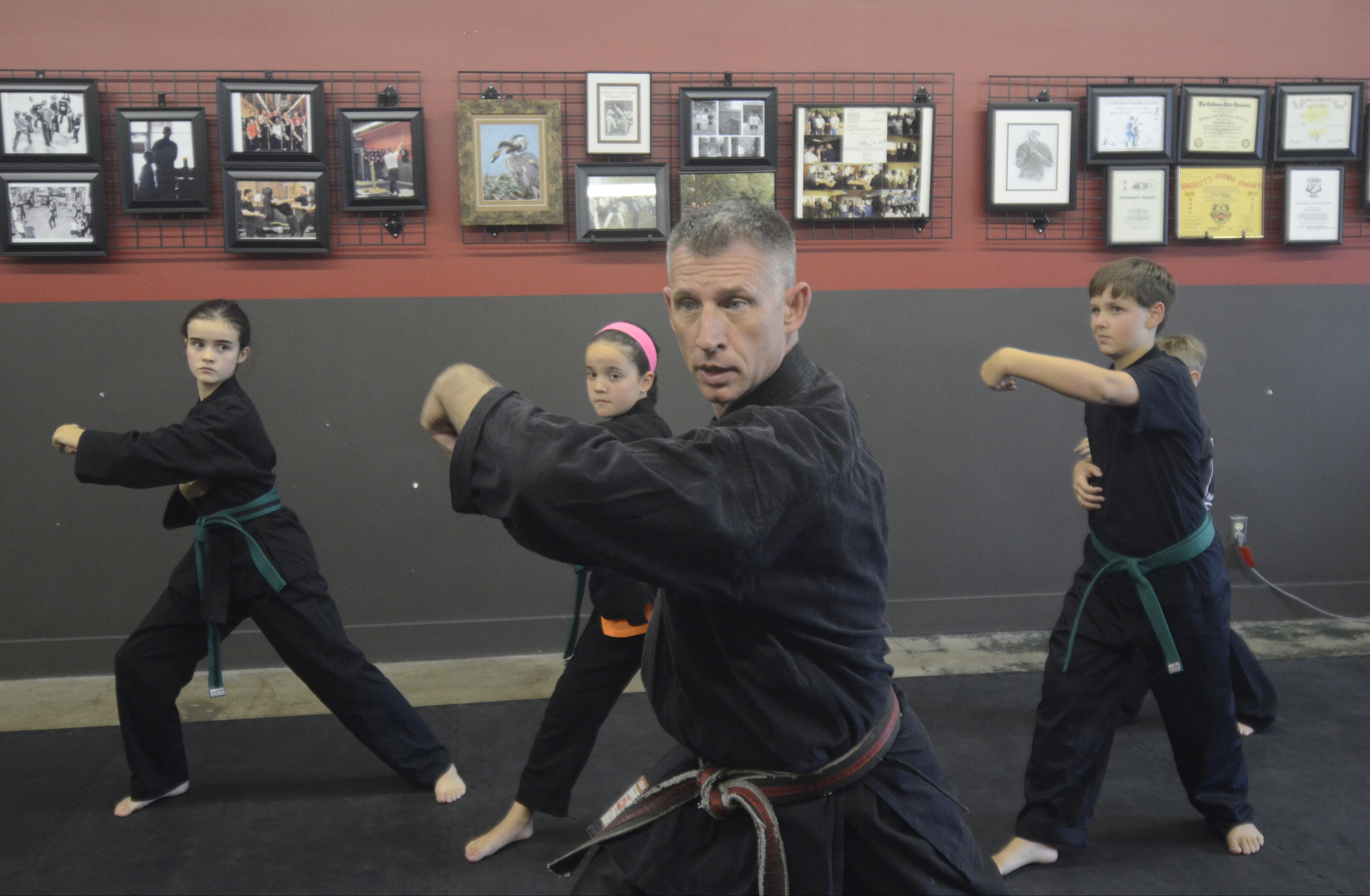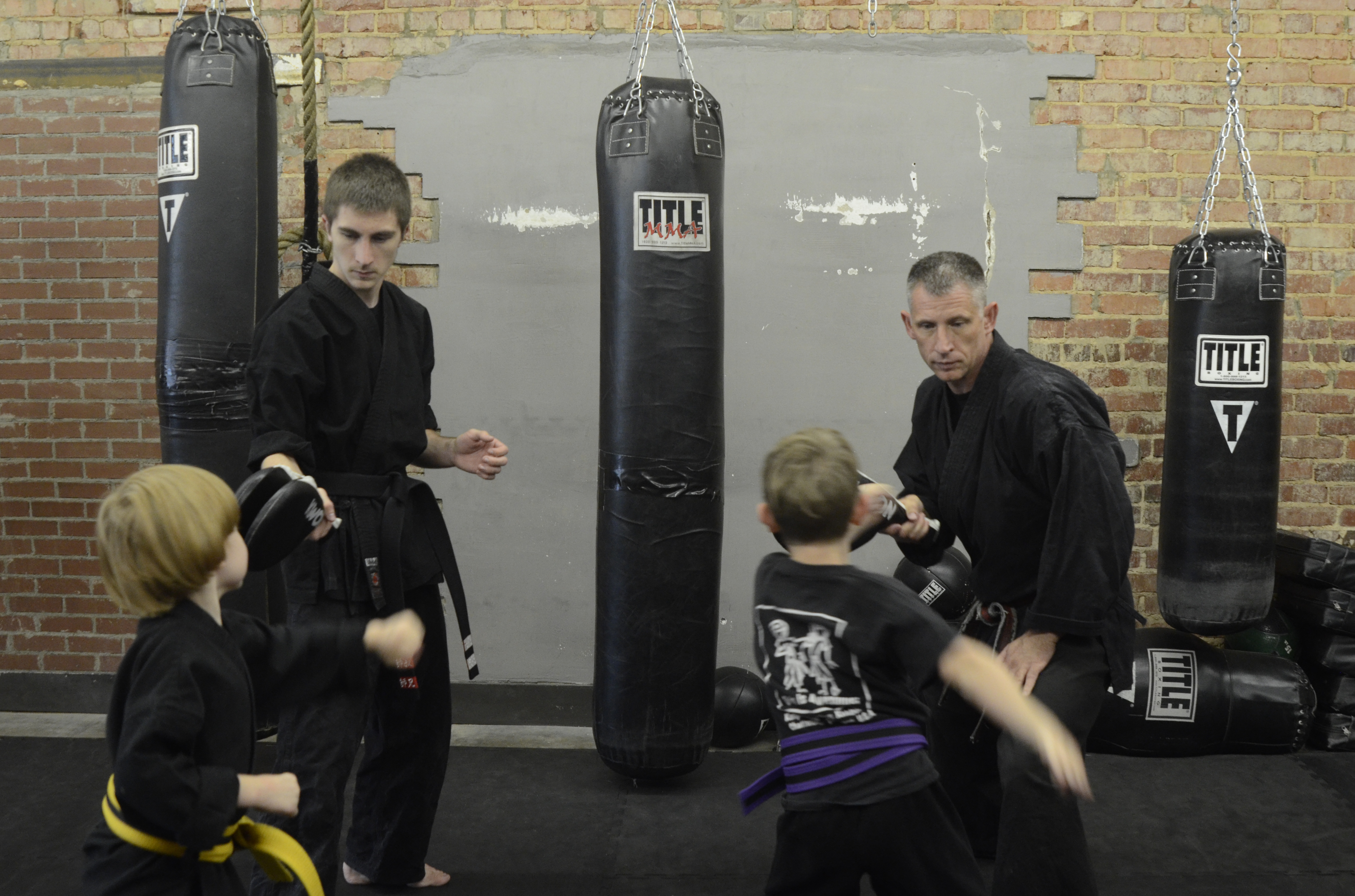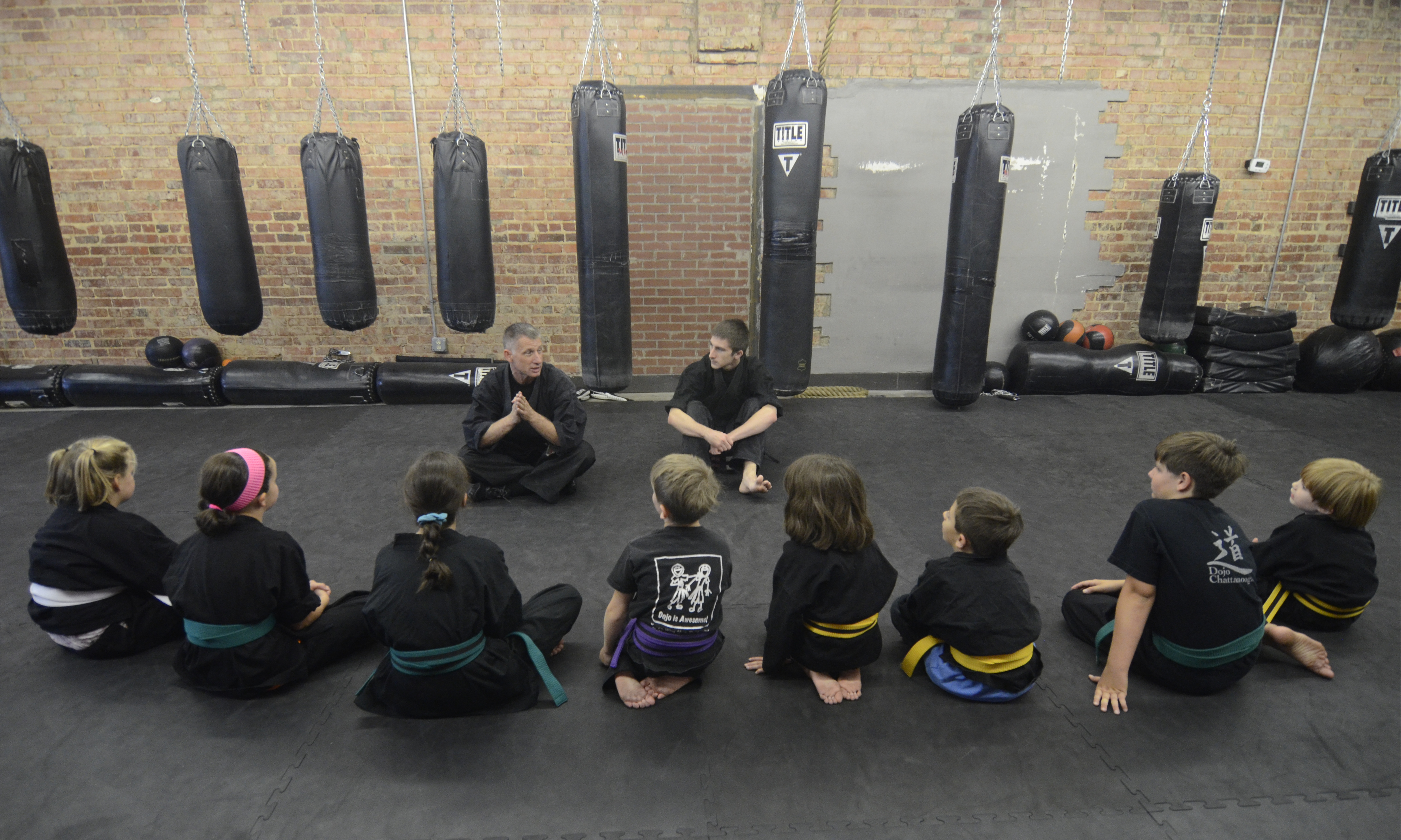Kin-Fu: Black belts are a fact of life for family of North Shore dojo owner (with video)
Friday, August 15, 2014
WHERE TO LEARNDojo Chattanooga, 323 Cherokee Blvd., offers courses for several styles, including adult and youth courses of Five Animal Kenpo, wing chun kung-fu, adult and youth fencing classes, fitness kickboxing and warrior fit conditioning. For more information, call 423-267-0855 or visit DojoChattanooga.com.FIVE ANIMAL KENPOIn 1997, Trevor Haines created a variation of American kenpo known as Five Animal Kenpo. Although it retains many of the basic tenants of traditional kenpo -- which borrows elements from martial traditions in China, Japan, Hawaii and America -- Haines says his form offers a "macro strategic overview of combat." It also incorporates the underlying philosphy of Shaolin kung fu, which centers on a rock-paper-scissors-like balance of power likened to the behavior of five different animals: dragon, snake, tiger, leopard and crane. For more information, including a store offering his 20-disc instructional DVD series, visit FiveAnimalKenpo.com.
For most children, homework and chores are just facts of life, obligatory obstacles to overcome on the path to adulthood.
In the Haines family, so is becoming a highly skilled martial artist.
A stocky 5-foot-8 with close-cropped, graying hair, Trevor Haines' 35 years of training have earned him a sixth-degree black belt in American kenpo karate as well as teaching licenses for wing chun kung-fu and fencing. In 1997, he developed his own style, known as Five Animal Kenpo.
While they were dating, Trevor began coaching his wife, Patricia, 49, who eventually attained a second-degree black belt in traditional kenpo. As each of their four children were born, they started training by age 5, and before they were allowed to quit, they had to earn a black belt, too.
"We treated martial arts like [most families] would school," Trevor explains while sitting near the front door of Dojo Chattanooga, his training studio on Cherokee Boulevard. "They all had their crisis moments when they said that they didn't want to go, and I told them that, after they got to their first-degree black belt, that could be their choice."
"[Martial arts] is not a hobby; it's who we are," Patricia says. "It's something that has bonded our family, which is awesome."
Despite being allowed to walk away afterward, however, his children treated a black belt as the next step in their studies, not the last one. Each of them continued to train in some form of martial arts for years after meeting their parents' mandatory goal.
A third-degree black belt, Zachary, 25, is on his second tour in Afghanistan with Army Special Forces. Jenna, 23, earned a second-degree belt, as did Jacob, 18, who became the last black belt in the family six years ago. Even though she chose to abandon kenpo when she received her black belt at age 10, Madison, now 20, shifted her training focus to fencing, which she studied for five years.
Within many martial arts styles, a black belt is awarded to practitioners who can prove that they have a firm grasp of the form and its principles. Achieving this rank typically requires several years of study and passing a series of previous tests to demonstrate one's mastery of prescribed skills.
In American kenpo, there are 10 degrees of black belt, reflecting various levels of proficiency as an instructor. By this system, those with second-degree belts are considered "associate/assistant instructors" while a sixth-degree belt holder is deemed a "professor," according to various Internet resources.
When Patricia took her black belt exam in 1990, she was pregnant with Jenna. Despite the strenuousness of taking an already difficult test while pregnant, she says she continued to train for several years afterward, if at a lower intensity.
"[The black belt] felt like more of a ... stepping stone, like there was more to come," Patricia says. "It was an opportunity to reflect back on what I'd learned and what it meant to me and to prepare myself for what was next."
EVERYBODY BE KUNG FU FAMILY
Although martial arts is the family business, Patricia and Trevor say they had other reasons for setting such a high bar for their children. Earning a black belt, Patricia says, requires mastery of valuable self-defense skills, but it also teaches self-discipline and improves confidence.
That they all share this achievement also has made for an unusual familial touchstone, Patricia adds.
Until 2004, the Haineses lived in Sacramento, Calif., where Trevor had been teaching kenpo 20 years earlier for the city parks and recreation department. He eventually founded his own studio, and over time, he attracted one of the largest student bases in the area.
For most of their childhood, however, his children weren't among his pupils, only joining their father during group classes. The rest of the time they studied privately with other instructors, a decision Trevor says was designed to eliminate friction caused by confusing the parent-child and master-student relationships.
"It was difficult to teach my family," he says. "There are times when I definitely feel like I was tougher on the kids than I probably was on other people's children. You have to push people sometimes past their comfort zones [during training] -- both physically and emotionally -- and it's a little more personal when it's your dad."
Despite his attempts to spare them from his own special expectations, Trevor's children say they sometimes felt obliged to excel because of his position.
"It wasn't hard to do the [belt] tests; it was hard to perform at the level everyone expected of the instructor's kids," says Jenna, who now serves as communications manager and publisher at St. Timothy's Episcopal Church on Signal Mountain.
But for the most part, she says, she enjoyed her time with her father, except at age 10 when the leadup to her black belt exam meant a few too many one-on-one, father-daughter training sessions.
"My dad and I were having lessons at least every other day, and I ended up falling apart in tears," she recalls, laughing at the memory. "The rule was that we couldn't quit. ... It became 'You can cry, but you're still going to have to do this.'"
Having conquered the black belt crucible, however, she says she and her father became even closer. Ultimately, all the Haines children say the benefits of sticking with their training was a smart move, one that continues to benefit them long after they left the dojo.
Madison says she continued to reap the benefit of training even when she was studying performing arts at the Cornish College of the Arts in Seattle.
"[Martial arts] is honestly the reason I was able to start dance as an older person and be able to pursue it professionally," she says. "It taught a lot of coordination as a child, gave me an incredible work ethic and my body was building muscle in ways that served well for dance."
Zachary, the highest-ranked practitioner in the family other than Trevor, readily admits he was treated more severely than his father's other students growing up. Nevertheless, he says, he emerged from his martial arts studies having been tempered by the experience.
"On a basic level, I approach the world with confidence and without fear because I know I am physically capable and skilled to protect myself," he writes in an email from Afghanistan. "More importantly than that, I have refined a strong moral, ethical and philosophical approach to life because of martial arts."
THE FAMILY THAT SPARS TOGETHER ...
Martial arts isn't just a two-generation tradition in the Haines family. Trevor received his first exposure to them as a child when his mother, an Air Force nurse, taught him basic judo principles she'd learned from studying the style while stationed in Japan.
Trevor teaches all his students a martial arts philosophy centered on avoiding confrontation whenever possible. One childhood bully, however, was the first of a handful of would-be assailants throughout his life who learned he was not to be trifled with.
"Billy Adkins, who lived up the street, was messing around with me, and I used a hip throw on him," he laughs while quickly torquing his body to flip an invisible assailant over his shoulder. "That was the end of the fight."
For the most part, the Haines family followed his example by embracing non-confrontation.
A notable exception was when a much larger man attempted to attack Jenna on the street while she was enrolled at New York University in Manhattan. Despite being about a foot shorter than her assailant and wearing heels and a dress at the time, she immobilized him with a joint lock -- a grappling technique that forces a joint into a position from which it cannot move. Frustrated, he attempted to escape by biting her hand, at which point she threw him to the ground.
"I felt pretty proud that a grown man had to resort to biting me," she says. "[My training] has made me more confident. I don't feel scared in situations that many of my female peers would."
As part of their upbringing in the family dojo, each of the Haines children spent at least some time assisting their father. As the last Haines still living at home, Jacob has played an even more active role than his older siblings, serving as a frequent assistant during classes and the sole kenpo instructor in his father's absence.
Jacob graduated from Chattanooga School for the Arts and Sciences last spring and will leave later this month for his first semester at the University of Memphis. He describes himself as occasionally absentminded, a trait he says likely would have prevented him from remaining committed to studying martial arts without his parents' black-belt mandate.
He likens achieving a black belt in his family to earning a high school diploma in others, an achievement that is no less noteworthy for being expected. Despite having no choice in studying martial arts, however, he says his journey to second-degree black belt -- perhaps third-degree as early as next year -- has been transformative in so many ways that he can't life without it.
"Martial arts is definitely a lifelong path to full development of being," he says. "There's no reason to stop learning to be, so in that sense, martial arts never stops."
Contact Casey Phillips at cphillips@timesfreepress.com or 423-757-6205. Follow him on Twitter at @PhillipsCTFP.


